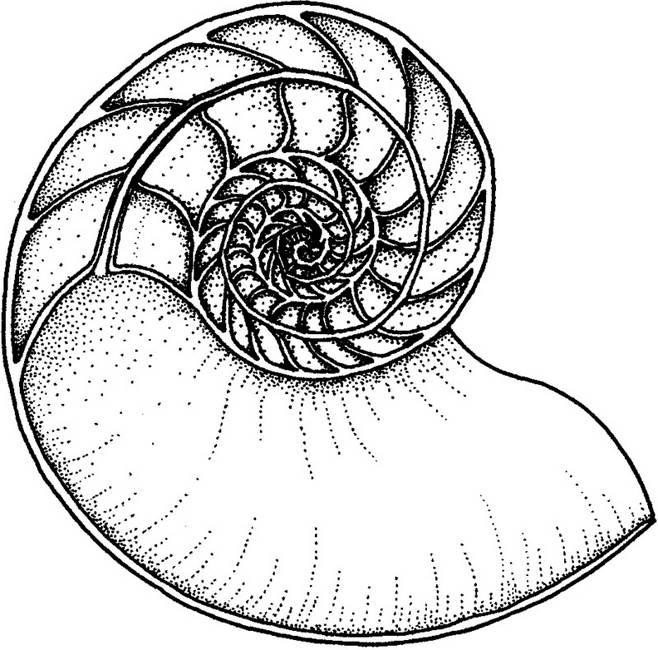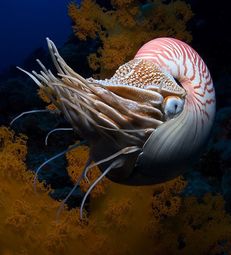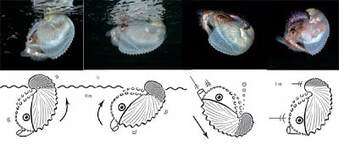
Nautilus is a cephalopod, a nearby relative of octopuses and squids. This creature can be found in the tropical waters of Indian and Pacific seas, close to the coral reefs, near depth areas of 300 to 600 meters. Nautilus are (like most marine species these days) affected by over-fishing and by the fact that their beautiful shells are sold as ornaments.
6 Fascinating Facts about Nautilus
Nautilus measure 20 to 25cm in average. Its shell is white to orange with brown zebra stripes. Internal side of the shell is pearly white.

The Nautilus’ shell is made of isolated chambers, Nautilus are born with 4 chambers and build new chambers through time. Grown-up nautilus have more than 30 chambers. The creature (looking like a little octopus) lives in the newest chamber, which is also the biggest. The other chambers are filled with air and water to control buoyancy. A tube called the siphuncle goes through each chamber and is used to pass liquid and gas from one chamber to the other. The gas is initially diluted in liquid in one chamber and bubbles out when released in a second low pressure chamber. Just like opening a can of soda..
1- Nautilus moves by jet-propulsion by blowing out water through a siphon. Position of the siphon decides the direction of the nautilus: front, back, upward or descending.
2- Nautilus has 90 tentacles, situated outside the shell to catch and manipulate their prey.
3- Nautilus has a beak which cuts their food (crabs, shrimps and fish), just like other members of the octopus family.
But unlike other members of the family, nautilus has poor visual perception. Eyes can only recognise light from dull, their smell is over developed and used for hunting their preys.
4- Nautilus spends their day at depths and moves toward the shallow water to hunt when the sun goes down.
Nautiluses mate only once a year. 75% of nautilus caught to be studied are male and only 25% are females. Researchers don’t really know why.
5- Nautiluses are living fossils. They have been living on planet earth for the last 500 million years with no adjustments in their appearance. Nautiluses occupied the Earth 265 million years before dinosaurs showed up.
Nautilus has a long life expectancy. It can survive over 15 years in nature.
6- A couple of nautiluses may have sex for up to 30 hours at a time... During intercourse, males often bite females on the mantle which will leave a mark on his partner’s shell.
Some male nautiluses attempt to mate with any object that that seems to have similar shape and size as an other nautilus, and this without making any difference between male or female.
Paper Nautilus
Nautilus seen in March 2021 during a black water dive from The Smiling Seahorse
nautilus buoyancy infographic
The reason I wrote this blog post is because we first came across this little fellow while diving Myanmar in 2017 but I just updated this article since our last sighting was in March 2021 in the Similans and we now have a few nice photos to add to this blogpost! :)
After some research, we found out that this weird creature is called paper nautilus or argonauts.
We apparently encountered a female Argonaut as male are 10 times smaller (rarely passing the size of 2cm) and dont have a shell.
Little is known about these creatures but I found these few facts interesting enough to share!
One of the male’s arm serves as a penis and is snapped off his body during sex to inseminate the female. The arms then remains inside the female body.
The female then secretes the papery shell with the tips of two tentacles. She lays her eggs inside the paper shell before using it as a house for herself.
But the real cool fact about argonauts is their BCD (buoyancy control device).
they are the only creature known to trap air bubble from the surface.
They swim to the surface, suck in some air from small vents on the top of their (non-compartmented) shells, close the holes with a tentacle before turning upside down and pushing themselves below the surface where they reach neutral buoyancy.
They can then swim effortlessly and weightless!


MORE ABOUT MARINE LIFE AND DIVING? |